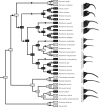Evolution of sexual dimorphism in bill size and shape of hermit hummingbirds (Phaethornithinae): a role for ecological causation
- PMID: 20194168
- PMCID: PMC2830232
- DOI: 10.1098/rstb.2009.0284
Evolution of sexual dimorphism in bill size and shape of hermit hummingbirds (Phaethornithinae): a role for ecological causation
Abstract
Unambiguous examples of ecological causation of sexual dimorphism are rare, and the best evidence involves sexual differences in trophic morphology. We show that moderate female-biased sexual dimorphism in bill curvature is the ancestral condition in hermit hummingbirds (Phaethornithinae), and that it is greatly amplified in species such as Glaucis hirsutus and Phaethornis guy, where bills of females are 60 per cent more curved than bills of males. In contrast, bill curvature dimorphism is lost or reduced in a lineage of short-billed hermit species and in specialist Eutoxeres sicklebill hermits. In the hermits, males tend to be larger than females in the majority of species, although size dimorphism is typically small. Consistent with earlier studies of hummingbird feeding performance, both raw regressions of traits and phylogenetic independent contrasts supported the prediction that dimorphism in bill curvature of hermits is associated with longer bills. Some evidence indicates that differences between sexes of hermit hummingbirds are associated with differences in the use of food plants. We suggest that some hermit hummingbirds provide model organisms for studies of ecological causation of sexual dimorphism because their sexual dimorphism in bill curvature provides a diagnostic clue for the food plants that need to be monitored for studies of sexual differences in resource use.
Figures




Similar articles
-
Evidence for ecological causation of sexual dimorphism in a hummingbird.Science. 2000 Jul 21;289(5478):441-3. doi: 10.1126/science.289.5478.441. Science. 2000. PMID: 10903203
-
Effect of flower shape and size on foraging performance and trade-offs in a tropical hummingbird.Ecology. 2009 May;90(5):1147-61. doi: 10.1890/08-0695.1. Ecology. 2009. PMID: 19537537
-
Ecology. Food fight drives evolution.Science. 2000 Jul 21;289(5478):369-71. doi: 10.1126/science.289.5478.369. Science. 2000. PMID: 10939937
-
Ecological causes for the evolution of sexual dimorphism: a review of the evidence.Q Rev Biol. 1989 Dec;64(4):419-61. doi: 10.1086/416458. Q Rev Biol. 1989. PMID: 2697022 Review.
-
The evolution of the avian bill as a thermoregulatory organ.Biol Rev Camb Philos Soc. 2017 Aug;92(3):1630-1656. doi: 10.1111/brv.12299. Epub 2016 Oct 7. Biol Rev Camb Philos Soc. 2017. PMID: 27714923 Review.
Cited by
-
Nectar feeding beyond the tongue: hummingbirds drink using phase-shifted bill opening, flexible tongue flaps and wringing at the tips.J Exp Biol. 2023 Apr 25;226(Suppl_1):jeb245074. doi: 10.1242/jeb.245074. Epub 2023 Apr 3. J Exp Biol. 2023. PMID: 37010268 Free PMC article.
-
Solitary meat-eaters: solitary, carnivorous carnivorans exhibit the highest degree of sexual size dimorphism.Sci Rep. 2019 Oct 25;9(1):15344. doi: 10.1038/s41598-019-51943-x. Sci Rep. 2019. PMID: 31653949 Free PMC article.
-
An analysis of beak shape variation in two ages of domestic turkeys (Meleagris gallopavo) using landmark-based geometric morphometrics.PLoS One. 2017 Sep 21;12(9):e0185159. doi: 10.1371/journal.pone.0185159. eCollection 2017. PLoS One. 2017. PMID: 28934330 Free PMC article.
-
Darwin's Galapagos finches in modern biology.Philos Trans R Soc Lond B Biol Sci. 2010 Apr 12;365(1543):1001-7. doi: 10.1098/rstb.2009.0321. Philos Trans R Soc Lond B Biol Sci. 2010. PMID: 20194163 Free PMC article.
-
Extreme bill dimorphism leads to different but overlapping isotopic niches and similar trophic positions in sexes of the charismatic extinct huia.Oecologia. 2022 Jan;198(1):67-77. doi: 10.1007/s00442-021-05082-8. Epub 2021 Nov 29. Oecologia. 2022. PMID: 34842996 Free PMC article.
References
-
- Altshuler D. L., Clark C. J.2003Darwin's hummingbirds. Science 300, 588–589 (doi:10.1126/science.1084477) - DOI - PubMed
-
- Bell J.19562619. Tangent, chord theorem. Math. Gaz. 40, 211–212 (doi:10.2307/3608819) - DOI
-
- Bleiweiss R.1998Tempo and mode of hummingbird evolution. Biol. J. Linn. Soc. 65, 63–76 (doi:10.1111/j.1095-8312.1998.tb00351) - DOI
-
- Bleiweiss R.1999Joint effects of feeding and breeding behaviour on trophic dimorphism in hummingbirds. Proc. R. Soc. Lond. B 266, 2491–2497 (doi:10.1098/rspb.1999.0951) - DOI - PMC - PubMed
-
- Bolnick D. I., Doebeli M.2003Sexual dimorphism and adaptive speciation: two sides of the same ecological coin. Evolution 57, 2433–2449 (doi:10.1554/02-595) - DOI - PubMed
Publication types
MeSH terms
LinkOut - more resources
Full Text Sources

